End-to-End 머신러닝 프로젝트
부동산 회사에 막 고용된 데이터 과학자라고 가정하고 예제 프로젝트를 처음부터 끝까지 (End-to-Enf) 진행하겠습니다. 주요 단계는 다음과 같습니다
- 큰 그림을 봅니다 (look at the big picture).
- 데이터를 구합니다 (get the data).
- 데이터로부터 통찰을 얻기 위해 탐색하고 시각화합니다 (discover and visualize the data to gain insights).
- 머신러닝 알고리즘을 위해 데이터를 준비합니다 (prepare the data for Machine Learning algorithms).
- 모델을 선택하고 훈련시킵니다 (select a model and train it).
- 모델을 상세하게 조정합니다 (fine-tune your model).
- 솔루션을 제시합니다 (present your solution).
- 시스템을 론칭하고 모니터링하고 유지 보수합니다 (launch, monitor, and maintain your system).
1. 큰 그림 보기 (Look at the Big Picture)
캘리포니아 인구조사 데이터를 사용해 캘리포니아의 주택 가격 모델을 만드는 것
현재 솔루션은? 전문가가 수동으로? 복잡한 규칙? 머신러닝?
문제정의
- 지도학습, 비지도학습, 강화학습 중에 어떤 경우에 해당하는가?
데이터에 label이 주어져 있기 때문에 지도학습이다. - 분류문제인가? 회귀문제인가?
집값이라는 것이 이산적인 값이 아니기에 회귀문제이다. - 배치학습batch learning, 온라인학습online learning 중 어떤 것을 사용해야 하는가?
데이터 전체를 한번에 쓰는가 아니면 학습된 시스템에 데이터가 계속해서 들어오는가? 인구조사라는게 굉장히 힘든 작업이라 1년에 한번 한다고 가정하면 배치학습에 가깝다
성능측정지표performance measure 선택
평균제곱근 오차RMSE root mean square error
2. 데이터 가져오기 (Get the Data)
- 작업환경 설정
# 윈도우는 아래 참조
# https://github.com/ageron/handson-ml/issues/525
$ export ML_PATH="$HOME/ml" # You can change the path if you prefer
$ mkdir -p $ML_PATH
$ python3 -m pip --version
pip 19.3.1 from [...]/lib/python3.7/site-packages/pip (python 3.7)
$ python3 -m pip install --user -U pip
Collecting pip
[...]
Successfully installed pip-19.3.1- 독립적인 환경(isolated environment) 만들기
$ python3 -m pip install --user -U virtualenv
Collecting virtualenv
[...]
Successfully installed virtualenv-16.7.6
$ cd $ML_PATH
$ python3 -m virtualenv my_env
Using base prefix '[...]'
New python executable in [...]/ml/my_env/bin/python3
Also creating executable in [...]/ml/my_env/
$ cd $ML_PATH
$ source my_env/bin/activate # on Linux or macOS
$ .\my_env\Scripts\activate # on Windows- 필요한 패키지들 설치하기
$ python3 -m pip install -U jupyter matplotlib numpy pandas scipy scikit-learn
Collecting jupyter
Downloading https://[...]/jupyter-1.0.0-py2.py3-none-any.whl
Collecting matplotlib
[...]
- 커널을 Jupyter에 등록하고 이름 정하기
$ python3 -m ipykernel install --user --name=python3- Jupyter 실행
$ jupyter notebook
[...] Serving notebooks from local directory: [...]/ml
[...] The Jupyter Notebook is running at:
[...] http://localhost:8888/?token=60995e108e44ac8d8865a[...]
[...] or http://127.0.0.1:8889/?token=60995e108e44ac8d8865a[...]
[...] Use Control-C to stop this server and shut down all kernels [...]데이터 다운로드
# Python ≥3.5 is required
import sys
assert sys.version_info >= (3, 5)
# Scikit-Learn ≥0.20 is required
import sklearn
assert sklearn.__version__ >= "0.20"
# Common imports
import numpy as np
import os
# To plot pretty figures
%matplotlib inline
import matplotlib as mpl
import matplotlib.pyplot as plt
mpl.rc('axes', labelsize=14)
mpl.rc('xtick', labelsize=12)
mpl.rc('ytick', labelsize=12)
# Where to save the figures
PROJECT_ROOT_DIR = "."
CHAPTER_ID = "end_to_end_project"
IMAGES_PATH = os.path.join(PROJECT_ROOT_DIR, "images", CHAPTER_ID)
os.makedirs(IMAGES_PATH, exist_ok=True)
def save_fig(fig_id, tight_layout=True, fig_extension="png", resolution=300):
path = os.path.join(IMAGES_PATH, fig_id + "." + fig_extension)
print("Saving figure", fig_id)
if tight_layout:
plt.tight_layout()
plt.savefig(path, format=fig_extension, dpi=resolution)
# Ignore useless warnings (see SciPy issue #5998)
import warnings
warnings.filterwarnings(action="ignore", message="^internal gelsd")import os
import tarfile
import urllib
DOWNLOAD_ROOT = "https://raw.githubusercontent.com/ageron/handson-ml2/master/"
HOUSING_PATH = os.path.join("datasets", "housing")
HOUSING_URL = DOWNLOAD_ROOT + "datasets/housing/housing.tgz"
def fetch_housing_data(housing_url=HOUSING_URL, housing_path=HOUSING_PATH):
if not os.path.isdir(housing_path):
os.makedirs(housing_path)
tgz_path = os.path.join(housing_path, "housing.tgz")
urllib.request.urlretrieve(housing_url, tgz_path)
housing_tgz = tarfile.open(tgz_path)
housing_tgz.extractall(path=housing_path)
housing_tgz.close()fetch_housing_data()
import pandas as pd
def load_housing_data(housing_path=HOUSING_PATH):
csv_path = os.path.join(housing_path, "housing.csv")
return pd.read_csv(csv_path)데이터 구조 훑어보기
housing = load_housing_data()
housing.head()housing.info()#ocean_proximity: 범주형(categorical) 필드
housing["ocean_proximity"].value_counts()housing.describe()#히스토그램으로 데이터 분석해보기
%matplotlib inline
import matplotlib.pyplot as plt
housing.hist(bins=50, figsize=(20,15))
save_fig("attribute_histogram_plots")
plt.show()그래프에서 툭 튀어나온 값이나 단위 값이 이상하다면 그 데이터의 전처리가 필요한 경우가 있다.
테스트 데이터셋 만들기
좋은 모델을 만들기 위해선 훈련에 사용되지 않고 모델평가만을 위해서 사용될 "테스트 데이터셋"을 따로 구분하는 것이 필요합니다. 테스트 데이터셋을 별도로 생성할 수도 있지만 프로젝트 초기의 경우 하나의 데이터셋을 훈련, 테스트용으로 분리하는 것이 일반적입니다.
#랜덤 작업을 해보자.
np.random.seed(42)import numpy as np
# For illustration only. Sklearn has train_test_split()
#몇 퍼센트를 테스트 데이터로 뽑을지 만드는 함수를 만든다.
def split_train_test(data, test_ratio):
shuffled_indices = np.random.permutation(len(data))
test_set_size = int(len(data) * test_ratio)
test_indices = shuffled_indices[:test_set_size]
train_indices = shuffled_indices[test_set_size:]
return data.iloc[train_indices], data.iloc[test_indices]
#a = np.random.permutation(10)
#array([8, 1, 5, 0, 7, 2, 9, 4, 3, 6])train_set, test_set = split_train_test(housing, 0.2)
len(train_set), len(test_set)
#(16512, 4128)새로운 데이터가 들어왔을때 다시 한번 분리작업을 하게된다. 이 분리 작업에서 이전 분류의 데이터들이 섞이는 문제가 생긴다. 따라서 테스트 데이터와 트레이닝 데이터의 유지를 위해서 샘플의 식별자를 사용해야 한다.
from zlib import crc32
#hashing 함수 crc32를 사용
def test_set_check(identifier, test_ratio):
return crc32(np.int64(identifier)) & 0xffffffff < test_ratio * 2**32
def split_train_test_by_id(data, test_ratio, id_column):
ids = data[id_column]
in_test_set = ids.apply(lambda id_: test_set_check(id_, test_ratio))
return data.loc[~in_test_set], data.loc[in_test_set]#인덱스를 id로 추가하기
housing_with_id = housing.reset_index() # adds an `index` column
train_set, test_set = split_train_test_by_id(housing_with_id, 0.2, "index")
housing_with_id.head()하지만 id가 행번호가 되면 데이터를 추가하거나 삭제하게 되면 id가 유지가 되지 않는다는 문제가 있다. 따라서 id를 만드는데 안전한 feature들을 사용해야 한다.
#대안으로 경도와 위도를 feature로서 id를 만드는데 사용한다.
housing_with_id["id"] = housing["longitude"] * 1000 + housing["latitude"]
train_set, test_set = split_train_test_by_id(housing_with_id, 0.2, "id")
train_set.head()Scikit-Learn에서 기본적으로 제공하는 데이터분할 함수
from sklearn.model_selection import train_test_split
train_set, test_set = train_test_split(housing, test_size=0.2, random_state=42)계층적 샘플링stratified sampling
투표를 생각해보면 전체 인구의 남녀, 특정 그룹의 비율들이 테스트 데이터 혹은 표본들에 그대로 유지가 되야한다.
계층적 샘플링 : 전체 데이터를 계층(strata)라는 동질의 그룹으로 나누고, 테스트 데이터가 전체 데이터를 잘 대표하도록 각 계층에서 올바른 수의 샘플을 추출
#상식적으로 봤을때 집가격과 수입은 비례할 것이다.
housing["median_income"].hist()#pandas cut을 사용하면 grouping이 편하다.
housing["income_cat"] = pd.cut(housing["median_income"],
bins=[0., 1.5, 3.0, 4.5, 6., np.inf],
labels=[1, 2, 3, 4, 5])
housing["income_cat"].value_counts()
->
3 7236
2 6581
4 3639
5 2362
1 822
Name: income_cat, dtype: int64#각각의 카테고리에 충분한 갯수의 샘플이 있어야 한다.
#적절하게 나누는 것이 중요하다.
housing["income_cat"].hist()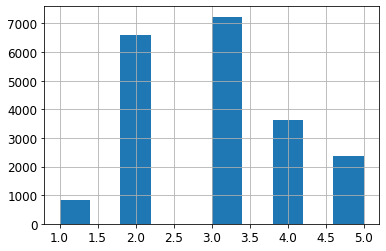
#scikit learn은 계층적 샘플링을 이미 제공한다.
from sklearn.model_selection import StratifiedShuffleSplit
split = StratifiedShuffleSplit(n_splits=1, test_size=0.2, random_state=42)
for train_index, test_index in split.split(housing, housing["income_cat"]):
strat_train_set = housing.loc[train_index]
strat_test_set = housing.loc[test_index]strat_train_set.info()housing["income_cat"].value_counts() / len(housing)
3 0.350581
2 0.318847
4 0.176308
5 0.114438
1 0.039826#비율이 유사하다.
strat_test_set["income_cat"].value_counts() / len(strat_test_set)
3 0.350533
2 0.318798
4 0.176357
5 0.114341
1 0.039971데이터 이해를 위한 탐색과 시각화
#backup
housing = strat_train_set.copy()#지리적 데이터 시각화
housing.plot(kind="scatter", x="longitude", y="latitude")
save_fig("bad_visualization_plot")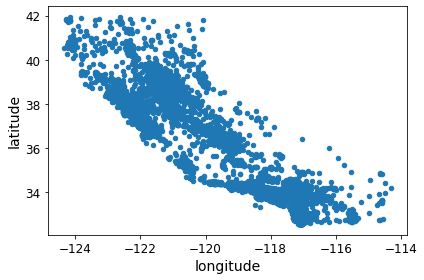
#알파옵션으로
housing.plot(kind="scatter", x="longitude", y="latitude", alpha=0.1)
save_fig("better_visualization_plot")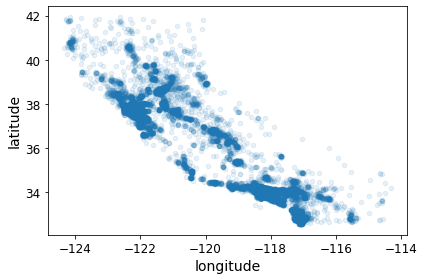
#더 다양한 정보 표시
#s:원의반지름, c:색상
housing.plot(kind="scatter", x="longitude", y="latitude", alpha=0.4,
s=housing["population"]/100, label="population", figsize=(10,7),
c="median_house_value", cmap=plt.get_cmap("jet"), colorbar=True,
sharex=False)
plt.legend()
save_fig("housing_prices_scatterplot")housing.plot(kind="scatter", x="longitude", y="latitude", alpha=0.4,
s=housing["population"]/100, label="population", figsize=(10,7),
c="median_house_value", cmap=plt.get_cmap("jet"), colorbar=True,
sharex=False)
plt.legend()
save_fig("housing_prices_scatterplot")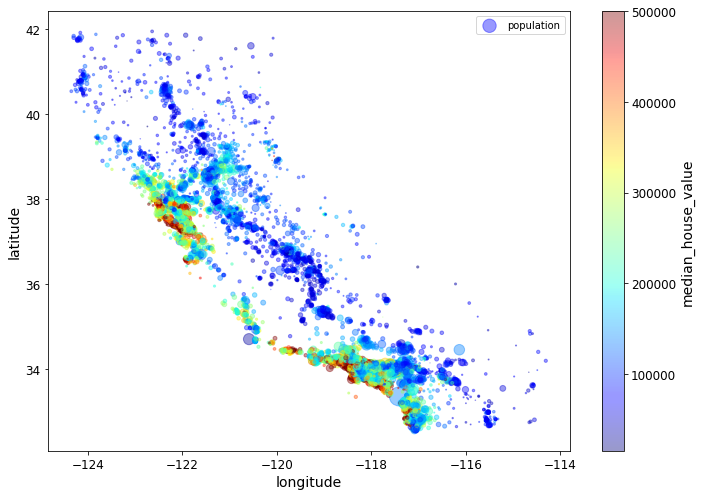
상관관계correlations 관찰하기
corr_matrix = housing.corr()
corr_matrix["median_house_value"].sort_values(ascending=False)
#일반적으로 절대값이 1에 가가워질수록 상관관계가 높다
median_house_value 1.000000
median_income 0.687151
total_rooms 0.135140
housing_median_age 0.114146
households 0.064590
total_bedrooms 0.047781
population -0.026882
longitude -0.047466
latitude -0.142673
Name: median_house_value, dtype: float64scatter_matrix 사용해서 상관관계 확인하기
# from pandas.tools.plotting import scatter_matrix # For older versions of Pandas
from pandas.plotting import scatter_matrix
# 특성 몇 개만 살펴봄
attributes = ["median_house_value", "median_income", "total_rooms",
"housing_median_age"]
scatter_matrix(housing[attributes], figsize=(12, 8))
save_fig("scatter_matrix_plot")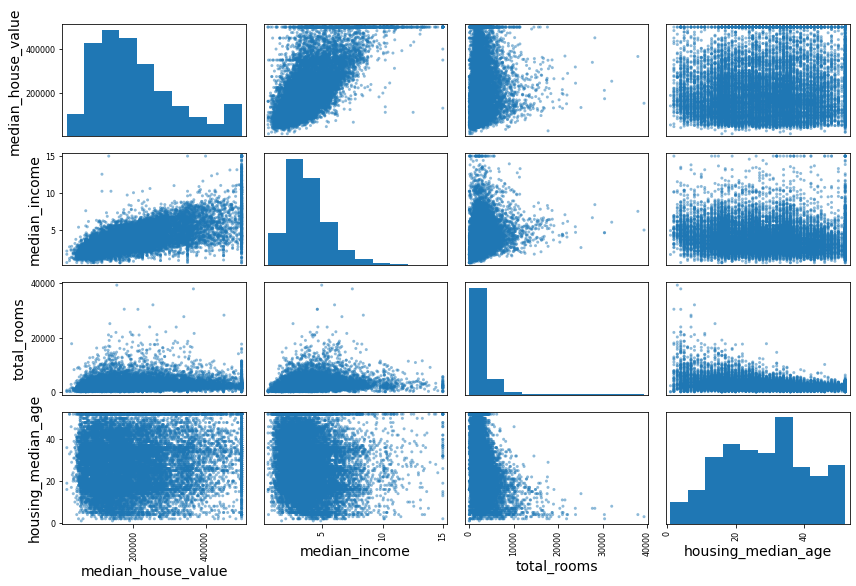
#대각 그래프들은 자기자신에 대한 정보라 의미가 없다.
housing.plot(kind="scatter", x="median_income", y="median_house_value",
alpha=0.1)
plt.axis([0, 16, 0, 550000])
save_fig("income_vs_house_value_scatterplot")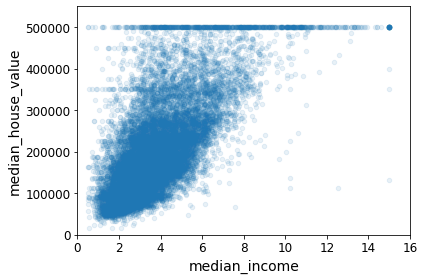
데이터를 시각화해서 살펴보면 데이터에 문제가 없는지를 발견하는데에 도움이 된다.
특성 조합들 실험
여러 특성(feature, attribute)들의 조합으로 새로운 특성을 정의해볼 수 있음
예를 들자면, 가구당 방 개수, 침대방(bedroom)의 비율, 가구당 인원
ousing["rooms_per_household"] = housing["total_rooms"]/housing["households"]
housing["bedrooms_per_room"] = housing["total_bedrooms"]/housing["total_rooms"]
housing["population_per_household"]=housing["population"]/housing["households"]corr_matrix = housing.corr()
corr_matrix["median_house_value"].sort_values(ascending=False)
#집에 방이 많을 수록 집이 비싸진다.
#한집에 있는 방 중에서 침실이 차지하는 비율 커질수록 집은 작아진다.
median_house_value 1.000000
median_income 0.687151
rooms_per_household 0.146255
total_rooms 0.135140
housing_median_age 0.114146
households 0.064590
total_bedrooms 0.047781
population_per_household -0.021991
population -0.026882
longitude -0.047466
latitude -0.142673
bedrooms_per_room -0.259952
Name: median_house_value, dtype: float64데이터 탐색과정은 대부분 한 번으로 끝나지 않고 모델을 만들고 문제점을 분석한 뒤 다시 실행하게 됩니다.
머신러닝 알고리즘을 위한 데이터 준비
데이터 준비는 데이터 변환(data transformation)과정으로 볼 수 있습니다.
데이터 수동변환 vs. 자동변환(함수만들기)
데이터 자동변환의 장점들
1.새로운 데이터에 대한 변환을 손쉽게 재생산(reproduce)할 수 있습니다.
2.향후에 재사용(reuse)할 수 있는 라이브러리를 구축하게 됩니다.
3.실제 시스템에서 가공되지 않은 데이터(raw data)를 알고리즘에 쉽게 입력으로 사용할 수 있도록 해줍니다.
4.여러 데이터 변환 방법을 쉽게 시도해 볼 수 있습니다.
#백업
housing = strat_train_set.drop("median_house_value", axis=1) # drop labels for training set
housing_labels = strat_train_set["median_house_value"].copy()데이터 정제data cleaning
누락된 값(missing values) 다루는 방법들
1.해당 구역을 제거(행을 제거)
2.해당 특성을 제거(열을 제거)
3.어떤 값으로 채움(0, 평균, 중간값 등)
#누락값 확인
12655 False
15502 False
2908 False
14053 False
20496 False
...
15174 False
12661 False
19263 False
19140 False
19773 False
Length: 16512, dtype: bool#missing value데이터프레임을 만들어줌
sample_incomplete_rows = housing[housing.isnull().any(axis=1)].head() # True if there is a null feature
sample_incomplete_rows1.해당구역제거
sample_incomplete_rows.dropna(subset=["total_bedrooms"]) # option 12.해당 특성을 제거(열을 제거)
sample_incomplete_rows.drop("total_bedrooms", axis=1) # option 23.어떤 값으로 채움(0, 평균, 중간값 등)
median = housing["total_bedrooms"].median()
sample_incomplete_rows["total_bedrooms"].fillna(median, inplace=True) # option 3대부분의 경우는 채우거나 보전해주는 방향으로 해결한다.
SimpleImputer 사용하기
자동으로 해준다!
from sklearn.impute import SimpleImputer
imputer = SimpleImputer(strategy="median")housing_num = housing.drop("ocean_proximity", axis=1)
imputer.fit(housing_num)
imputer.statistics_
array([-118.51 , 34.26 , 29. , 2119. , 433. ,
1164. , 408. , 3.54155])
housing_num.median().values
array([-118.51 , 34.26 , 29. , 2119. , 433. ,
1164. , 408. , 3.54155])X = imputer.transform(housing_num)이제 학습된 imputer 객체를 사용해 누락된 값을 중간값으로 바꿀 수 있습니다.
X = imputer.transform(housing_num)위 X는 NumPy array입니다. 이를 다시 pandas DataFrame으로 되돌릴 수 있습니다.
housing_tr = pd.DataFrame(X, columns=housing_num.columns,
index=housing.index)제대로 채워져 있는지 확인해봅니다.
sample_incomplete_rows.index.values
housing_num.loc[sample_incomplete_rows.index.values]
housing_tr.loc[sample_incomplete_rows.index.values]Estimator, Transformer, Predictor
Fit transform을 알아보자.
-
추정기(estimator): 데이터셋을 기반으로 모델 파라미터들을 추정하는 객체를 추정기라고 합니다(예를 들자면 imputer). 추정자체는 fit() method에 의해서 수행되고 하나의 데이터셋을 매개변수로 전달받습니다(지도학습의 경우 label을 담고 있는 데이터셋을 추가적인 매개변수로 전달).
-
변환기(transformer): (imputer같이) 데이터셋을 변환하는 추정기를 변환기라고 합니다. 변환은 transform() method가 수행합니다. 그리고 변환된 데이터셋을 반환합니다.
-
예측기(predictor): 일부 추정기는 주어진 새로운 데이터셋에 대해 예측값을 생성할 수 있습니다. 앞에서 사용했던 LinearRegression도 예측기입니다. 예측기의 predict() method는 새로운 데이터셋을 받아 예측값을 반환합니다. 그리고 score() method는 예측값에 대한 평가지표를 반환합니다.
텍스트와 범주형 특성 다루기
대부분의 모델은 숫자를 인풋으로 받아들인다.
따라서 텍스트를 numerical한 형태로 바꾸어줄 필요가 있다.
housing_cat = housing[["ocean_proximity"]]
housing_cat.head(10)
ocean_proximity
12655 INLAND
15502 NEAR OCEAN
2908 INLAND
14053 NEAR OCEAN
20496 <1H OCEAN
1481 NEAR BAY
18125 <1H OCEAN
5830 <1H OCEAN
17989 <1H OCEAN
4861 <1H OCEANordinalencoder
#ordinalencoder
from sklearn.preprocessing import OrdinalEncoder
ordinal_encoder = OrdinalEncoder()
housing_cat_encoded = ordinal_encoder.fit_transform(housing_cat)
housing_cat_encoded[:10] ->
array([[1.],
[4.],
[1.],
[4.],
[0.],
[3.],
[0.],
[0.],
[0.],
[0.]])
ordinal_encoder.categories_ ->
[array(['<1H OCEAN', 'INLAND', 'ISLAND', 'NEAR BAY', 'NEAR OCEAN'],
dtype=object)]"특성의 값이 비슷할수록 두 개의 샘플이 비슷하다"가 성립할 때 모델학습이 쉬워진다. 위 방식은 구분만 했을뿐 값이 가지는 유사성을 표현하지는 못한다.
One-hot encoding
#saprse matrix
from sklearn.preprocessing import OneHotEncoder
cat_encoder = OneHotEncoder()
housing_cat_1hot = cat_encoder.fit_transform(housing_cat)
housing_cat_1hot
housing_cat_1hot.toarray() ->
array([[0., 1., 0., 0., 0.],
[0., 0., 0., 0., 1.],
[0., 1., 0., 0., 0.],
...,
[1., 0., 0., 0., 0.],
[1., 0., 0., 0., 0.],
[0., 1., 0., 0., 0.]])#일반적인 array
cat_encoder = OneHotEncoder(sparse=False)
housing_cat_1hot = cat_encoder.fit_transform(housing_cat)
housing_cat_1hot ->
array([[0., 1., 0., 0., 0.],
[0., 0., 0., 0., 1.],
[0., 1., 0., 0., 0.],
...,
[1., 0., 0., 0., 0.],
[1., 0., 0., 0., 0.],
[0., 1., 0., 0., 0.]])
cat_encoder.categories_ ->
[array(['<1H OCEAN', 'INLAND', 'ISLAND', 'NEAR BAY', 'NEAR OCEAN'],
dtype=object)]나만의 변환기(Custom Transformers) 만들기
Scikit-Learn이 유용한 변환기를 많이 제공하지만 프로젝트를 위해 특별한 데이터 처리 작업을 해야 할 경우가 많습니다. 이 때 나만의 변환기를 만들 수 있습니다.
반드시 구현해야 할 method들
1.fit()
2.transform()
아래의 custom tranformer는 rooms_per_household, population_per_household 두 개의 새로운 특성을 데이터셋에 추가하며 add_bedrooms_per_room = True로 주어지면 bedrooms_per_room 특성까지 추가합니다. add_bedrooms_per_room은 하이퍼파라미터.
from sklearn.base import BaseEstimator, TransformerMixin
# column index
rooms_ix, bedrooms_ix, population_ix, households_ix = 3, 4, 5, 6
class CombinedAttributesAdder(BaseEstimator, TransformerMixin):
def __init__(self, add_bedrooms_per_room = True): # no *args or **kargs
self.add_bedrooms_per_room = add_bedrooms_per_room
def fit(self, X, y=None):
return self # nothing else to do
def transform(self, X):
rooms_per_household = X[:, rooms_ix] / X[:, households_ix]
population_per_household = X[:, population_ix] / X[:, households_ix]
if self.add_bedrooms_per_room:
bedrooms_per_room = X[:, bedrooms_ix] / X[:, rooms_ix]
return np.c_[X, rooms_per_household, population_per_household,
bedrooms_per_room]
else:
return np.c_[X, rooms_per_household, population_per_household]
attr_adder = CombinedAttributesAdder(add_bedrooms_per_room=False)
housing_extra_attribs = attr_adder.transform(housing.values)Numpy데이터를 DataFrame으로 변환
housing_extra_attribs = pd.DataFrame(
housing_extra_attribs,
columns=list(housing.columns)+["rooms_per_household", "population_per_household"],
index=housing.index)
housing_extra_attribs.head()특성 스케일링(Feature Scaling)
1.Min-max scaling : 0과 1사이의 값이 되도록 조정
2.표준화(standardization) : 평균이 0, 분산이 1이 되도록 만들어 줌(사이킷런의 StandardScaler사용)
변환 파이프라인(Transformation Pipelines)
여러 개의 변환이 순차적으로 이루어져야 할 경우 Pipeline class를 사용하면 편합니다.
from sklearn.pipeline import Pipeline
from sklearn.preprocessing import StandardScaler
num_pipeline = Pipeline([
('imputer', SimpleImputer(strategy="median")),
('attribs_adder', CombinedAttributesAdder()),
('std_scaler', StandardScaler()),
])
housing_num_tr = num_pipeline.fit_transform(housing_num)이름, 추정기 쌍의 목록
마지막 단계를 제외하고 모두 변환기여야 합니다(fit_transform() method를 가지고 있어야 함).
파이프라인의 fit() method를 호출하면 모든 변환기의 fit_transform() method를 순서대로 호출하면서 한 단계의 출력을 다음 단계의 입력으로 전달합니다. 마지막 단계에서는 fit() method만 호출합니다.
housing_num_tr ->
array([[-0.94135046, 1.34743822, 0.02756357, ..., 0.01739526,
0.00622264, -0.12112176],
[ 1.17178212, -1.19243966, -1.72201763, ..., 0.56925554,
-0.04081077, -0.81086696],
[ 0.26758118, -0.1259716 , 1.22045984, ..., -0.01802432,
-0.07537122, -0.33827252],
...,
[-1.5707942 , 1.31001828, 1.53856552, ..., -0.5092404 ,
-0.03743619, 0.32286937],
[-1.56080303, 1.2492109 , -1.1653327 , ..., 0.32814891,
-0.05915604, -0.45702273],
[-1.28105026, 2.02567448, -0.13148926, ..., 0.01407228,
0.00657083, -0.12169672]])각 열(column) 마다 다른 파이프라인을 적용할 수도 있습니다! 예를 들어 수치형 특성들과 범주형 특성들에 대해 별도의 변환이 필요하다면 아래와 같이 ColumnTransformer를 사용하면 됩니다.
from sklearn.compose import ColumnTransformer
num_attribs = list(housing_num)
cat_attribs = ["ocean_proximity"]
full_pipeline = ColumnTransformer([
("num", num_pipeline, num_attribs),
("cat", OneHotEncoder(), cat_attribs),
])
housing_prepared = full_pipeline.fit_transform(housing)
housing_prepared ->
array([[-0.94135046, 1.34743822, 0.02756357, ..., 0. ,
0. , 0. ],
[ 1.17178212, -1.19243966, -1.72201763, ..., 0. ,
0. , 1. ],
[ 0.26758118, -0.1259716 , 1.22045984, ..., 0. ,
0. , 0. ],
...,
[-1.5707942 , 1.31001828, 1.53856552, ..., 0. ,
0. , 0. ],
[-1.56080303, 1.2492109 , -1.1653327 , ..., 0. ,
0. , 0. ],
[-1.28105026, 2.02567448, -0.13148926, ..., 0. ,
0. , 0. ]])
housing_prepared.shape, housing.shape ->
((16512, 16), (16512, 9))모델 훈련(Train a Model)
드디어 모델을 훈련시킬 준비가 되었습니다! 지난 시간에 배웠던 선형회귀모델(linear regression)을 사용해보겠습니다.
from sklearn.linear_model import LinearRegression
#인스턴스 형성
lin_reg = LinearRegression()
lin_reg.fit(housing_prepared, housing_labels)모델훈련은 딱 3줄의 코드면 충분합니다!
몇 개의 샘플에 모델을 적용해서 예측값을 확인해보고 실제값과 비교해보겠습니다.
#파라미터 값들을 확인, 16개
#선형회귀 모델이기 때문에 파라미터는 계수의 값들이다.
lin_reg.coef_ ->
array([-55649.63398453, -56711.59742892, 13734.72084192, -1943.05586355,
7343.22979731, -45709.28253579, 45453.26277662, 74714.15226133,
6604.58396628, 1043.05452981, 9248.31607777, -18015.98870784,
-55214.71083473, 110357.8461062 , -22484.65997391, -14642.48658971])#계수값이 크거나 작거나에 따라서 어떤 식으로 모델에 영향을 미치는 지를 알고 싶다.
extra_attribs = ["rooms_per_hhold", "pop_per_hhold", "bedrooms_per_room"]
cat_encoder = full_pipeline.named_transformers_["cat"]
cat_one_hot_attribs = list(cat_encoder.categories_[0])
attributes = num_attribs + extra_attribs + cat_one_hot_attribs
sorted(zip(lin_reg.coef_, attributes), reverse=True) ->
#계수가 높을 수록 영향력이 크다.
#집이 섬에 있다면 집값이 비싸고
#소득이 높을 수록 집값이 비싸고
#latitude 북쪽으로 갈수록 집값이 저렴해진다.
#다만 feature들 가운데 몇가지는 겹치는 경우가 있기에
#단순 계수로 feature의 중요성을 평가하기는 어렵다.
[(110357.84610619607, 'ISLAND'),
(74714.15226132619, 'median_income'),
(45453.262776622236, 'households'),
(13734.720841922466, 'housing_median_age'),
(9248.31607776975, 'bedrooms_per_room'),
(7343.229797309003, 'total_bedrooms'),
(6604.583966284028, 'rooms_per_hhold'),
(1043.0545298050245, 'pop_per_hhold'),
(-1943.0558635496077, 'total_rooms'),
(-14642.48658971256, 'NEAR OCEAN'),
(-18015.98870783896, '<1H OCEAN'),
(-22484.659973912247, 'NEAR BAY'),
(-45709.28253579062, 'population'),
(-55214.71083473229, 'INLAND'),
(-55649.63398452769, 'longitude'),
(-56711.597428916226, 'latitude')]# 몇 개의 샘플에 대해 데이터변환 및 예측을 해보자
some_data = housing.iloc[:5]
some_labels = housing_labels.iloc[:5]
some_data_prepared = full_pipeline.transform(some_data)
print("Predictions:", lin_reg.predict(some_data_prepared).round(decimals=1)) ->
#5개의 데이터 샘플에 대해서
Predictions: [ 85657.9 305492.6 152056.5 186095.7 244550.7]
print("Labels:", list(some_labels)) ->
#label과 비교해보면 대략 맞다.
Labels: [72100.0, 279600.0, 82700.0, 112500.0, 238300.0]RMSE를 측정
from sklearn.metrics import mean_squared_error
housing_predictions = lin_reg.predict(housing_prepared)
lin_mse = mean_squared_error(housing_labels, housing_predictions)
lin_rmse = np.sqrt(lin_mse)
lin_rmse ->
#집값을 예측하려는 것인데 7만불정도 차이가 난다.
68627.87390018745훈련 데이터셋의 RMSE가 이 경우처럼 큰 경우 => 과소적합(under-fitting)
과소적합이 일어나는 이유?
1.특성들(features)이 충분한 정보를 제공하지 못함
2.모델이 충분히 강력하지 못함
강력한 비선형모델인 DecisionTreeRegressor
이진트리의 구조다. 자세한건 모르겠다..
#학습
from sklearn.tree import DecisionTreeRegressor
tree_reg = DecisionTreeRegressor(random_state=42)
tree_reg.fit(housing_prepared, housing_labels)#RMSE 측정
housing_predictions = tree_reg.predict(housing_prepared)
tree_mse = mean_squared_error(housing_labels, housing_predictions)
tree_rmse = np.sqrt(tree_mse)
tree_rmse ->
0이 모델이 선형모델보다 낫다고 말할 수 있을까요? 어떻게 알 수 있을까요?
1.테스트 데이터셋을 이용한 검증 -> 비추, 가능하면 테스트 데이터는 모델을 론칭 직전까지 미루자.
2.훈련 데이터셋의 일부를 검증데이터(validation data)셋으로 분리해서 검증
3.k-겹 교차 검증(k-fold cross-validation)
교차 검증(Cross-Validation)을 사용한 평가
결정트리 모델에 대한 평가
from sklearn.model_selection import cross_val_score
scores = cross_val_score(tree_reg, housing_prepared, housing_labels,
scoring="neg_mean_squared_error", cv=10)
tree_rmse_scores = np.sqrt(-scores)def display_scores(scores):
print("Scores:", scores)
print("Mean:", scores.mean())
print("Standard deviation:", scores.std())
display_scores(tree_rmse_scores) ->
#10번의 학습을 시켰다.
#Mean score는 71400정도가 되었다. 작을수록 좋다.
#overfitting을 확인할 수 있다.
Scores: [72831.45749112 69973.18438322 69528.56551415 72517.78229792
69145.50006909 79094.74123727 68960.045444 73344.50225684
69826.02473916 71077.09753998]
Mean: 71629.89009727491
Standard deviation: 2914.035468468928선형회귀모델에 대한 평가
lin_scores = cross_val_score(lin_reg, housing_prepared, housing_labels,
scoring="neg_mean_squared_error", cv=10)
lin_rmse_scores = np.sqrt(-lin_scores)
display_scores(lin_rmse_scores) ->
#트리 모델보다 낫다.
Scores: [71762.76364394 64114.99166359 67771.17124356 68635.19072082
66846.14089488 72528.03725385 73997.08050233 68802.33629334
66443.28836884 70139.79923956]
Mean: 69104.07998247063
Standard deviation: 2880.3282098180666RandomForestRegressor
여러개의 값들의 평균을 구해서 predict를 하므로 하나의 결정트리보다 좋은 결과가 나오는 경우가 많다.
#100개의 트리를 사용한다ㄷㄷ
from sklearn.ensemble import RandomForestRegressor
forest_reg = RandomForestRegressor(n_estimators=100, random_state=42)
forest_reg.fit(housing_prepared, housing_labels)housing_predictions = forest_reg.predict(housing_prepared)
forest_mse = mean_squared_error(housing_labels, housing_predictions)
forest_rmse = np.sqrt(forest_mse)
forest_rmse ->
18650.698705770003from sklearn.model_selection import cross_val_score
forest_scores = cross_val_score(forest_reg, housing_prepared, housing_labels,
scoring="neg_mean_squared_error", cv=10)
forest_rmse_scores = np.sqrt(-forest_scores)
display_scores(forest_rmse_scores) ->
#세 모델 중 가장 성능이 좋다.
Scores: [51559.63379638 48737.57100062 47210.51269766 51875.21247297
47577.50470123 51863.27467888 52746.34645573 50065.1762751
48664.66818196 54055.90894609]
Mean: 50435.58092066179
Standard deviation: 2203.3381412764606모델 세부 튜닝(Fine-Tune Your Model)
모델의 종류를 선택한 후에 모델을 세부 튜닝하는 것이 필요합니다. 모델 학습을 위한 최적의 하이퍼파라미터를 찾는 과정이라고 말할 수 있습니다.
그리드 탐색(Grid Search)
수동으로 하이퍼파라미터 조합을 시도하는 대신 Scikit learn에서 제공하는 GridSearchCV를 사용하는 것이 좋습니다.
from sklearn.model_selection import GridSearchCV
param_grid = [
# try 12 (3×4) combinations of hyperparameters
{'n_estimators': [3, 10, 30], 'max_features': [2, 4, 6, 8]},
# then try 6 (2×3) combinations with bootstrap set as False
# all 18
{'bootstrap': [False], 'n_estimators': [3, 10], 'max_features': [2, 3, 4]},
]
forest_reg = RandomForestRegressor(random_state=42)
# train across 5 folds, that's a total of (12+6)*5=90 rounds of training
grid_search = GridSearchCV(forest_reg, param_grid, cv=5,
scoring='neg_mean_squared_error',
return_train_score=True)
grid_search.fit(housing_prepared, housing_labels) ->
GridSearchCV(cv=5, estimator=RandomForestRegressor(random_state=42),
param_grid=[{'max_features': [2, 4, 6, 8],
'n_estimators': [3, 10, 30]},
{'bootstrap': [False], 'max_features': [2, 3, 4],
'n_estimators': [3, 10]}],
return_train_score=True, scoring='neg_mean_squared_error')# 가장 좋은 모델을 만들어내는 조합을 알고 싶다면
grid_search.best_params_ ->
{'max_features': 8, 'n_estimators': 30}
grid_search.best_estimator_ ->
RandomForestRegressor(max_features=8, n_estimators=30, random_state=42)cvres = grid_search.cv_results_
for mean_score, params in zip(cvres["mean_test_score"], cvres["params"]):
print(np.sqrt(-mean_score), params) ->
63895.161577951665 {'max_features': 2, 'n_estimators': 3}
54916.32386349543 {'max_features': 2, 'n_estimators': 10}
52885.86715332332 {'max_features': 2, 'n_estimators': 30}
60075.3680329983 {'max_features': 4, 'n_estimators': 3}
52495.01284985185 {'max_features': 4, 'n_estimators': 10}
50187.24324926565 {'max_features': 4, 'n_estimators': 30}
58064.73529982314 {'max_features': 6, 'n_estimators': 3}
51519.32062366315 {'max_features': 6, 'n_estimators': 10}
49969.80441627874 {'max_features': 6, 'n_estimators': 30}
58895.824998155826 {'max_features': 8, 'n_estimators': 3}
52459.79624724529 {'max_features': 8, 'n_estimators': 10}
49898.98913455217 {'max_features': 8, 'n_estimators': 30}
62381.765106921855 {'bootstrap': False, 'max_features': 2, 'n_estimators': 3}
54476.57050944266 {'bootstrap': False, 'max_features': 2, 'n_estimators': 10}
59974.60028085155 {'bootstrap': False, 'max_features': 3, 'n_estimators': 3}
52754.5632813202 {'bootstrap': False, 'max_features': 3, 'n_estimators': 10}
57831.136061214274 {'bootstrap': False, 'max_features': 4, 'n_estimators': 3}
51278.37877140253 {'bootstrap': False, 'max_features': 4, 'n_estimators': 10}랜덤 탐색(Randomized Search)
하이퍼파라미터 조합의 수가 큰 경우에 유리. 지정한 횟수만큼만 평가.
from sklearn.model_selection import RandomizedSearchCV
from scipy.stats import randint
param_distribs = {
'n_estimators': randint(low=1, high=200),
'max_features': randint(low=1, high=8),
}
forest_reg = RandomForestRegressor(random_state=42)
rnd_search = RandomizedSearchCV(forest_reg, param_distributions=param_distribs,
n_iter=10, cv=5, scoring='neg_mean_squared_error', random_state=42)
rnd_search.fit(housing_prepared, housing_labels) ->
RandomizedSearchCV(cv=5, estimator=RandomForestRegressor(random_state=42),
param_distributions={'max_features': <scipy.stats._distn_infrastructure.rv_frozen object at 0x0000019010258CD0>,
'n_estimators': <scipy.stats._distn_infrastructure.rv_frozen object at 0x000001900E3386A0>},
random_state=42, scoring='neg_mean_squared_error')cvres = rnd_search.cv_results_
for mean_score, params in zip(cvres["mean_test_score"], cvres["params"]):
print(np.sqrt(-mean_score), params) ->
#10번 시도 했기때문에 10개의 조합이 나왔다.
49117.55344336652 {'max_features': 7, 'n_estimators': 180}
51450.63202856348 {'max_features': 5, 'n_estimators': 15}
50692.53588182537 {'max_features': 3, 'n_estimators': 72}
50783.614493515 {'max_features': 5, 'n_estimators': 21}
49162.89877456354 {'max_features': 7, 'n_estimators': 122}
50655.798471042704 {'max_features': 3, 'n_estimators': 75}
50513.856319990606 {'max_features': 3, 'n_estimators': 88}
49521.17201976928 {'max_features': 5, 'n_estimators': 100}
50302.90440763418 {'max_features': 3, 'n_estimators': 150}
65167.02018649492 {'max_features': 5, 'n_estimators': 2}특성 중요도, 에러 분석
feature_importances = grid_search.best_estimator_.feature_importances_
feature_importances ->
array([6.96542523e-02, 6.04213840e-02, 4.21882202e-02, 1.52450557e-02,
1.55545295e-02, 1.58491147e-02, 1.49346552e-02, 3.79009225e-01,
5.47789150e-02, 1.07031322e-01, 4.82031213e-02, 6.79266007e-03,
1.65706303e-01, 7.83480660e-05, 1.52473276e-03, 3.02816106e-03])feature들과 연결해서 출력
extra_attribs = ["rooms_per_hhold", "pop_per_hhold", "bedrooms_per_room"]
#cat_encoder = cat_pipeline.named_steps["cat_encoder"] # old solution
cat_encoder = full_pipeline.named_transformers_["cat"]
cat_one_hot_attribs = list(cat_encoder.categories_[0])
attributes = num_attribs + extra_attribs + cat_one_hot_attribs
sorted(zip(feature_importances, attributes), reverse=True) ->
#소득이 가장 중요하다.
[(0.3790092248170967, 'median_income'),
(0.16570630316895876, 'INLAND'),
(0.10703132208204355, 'pop_per_hhold'),
(0.06965425227942929, 'longitude'),
(0.0604213840080722, 'latitude'),
(0.054778915018283726, 'rooms_per_hhold'),
(0.048203121338269206, 'bedrooms_per_room'),
(0.04218822024391753, 'housing_median_age'),
(0.015849114744428634, 'population'),
(0.015554529490469328, 'total_bedrooms'),
(0.01524505568840977, 'total_rooms'),
(0.014934655161887772, 'households'),
(0.006792660074259966, '<1H OCEAN'),
(0.0030281610628962747, 'NEAR OCEAN'),
(0.0015247327555504937, 'NEAR BAY'),
(7.834806602687504e-05, 'ISLAND')]테스트 데이터셋으로 최종 평가하기
#모델 선정 완료
final_model = grid_search.best_estimator_
X_test = strat_test_set.drop("median_house_value", axis=1)
y_test = strat_test_set["median_house_value"].copy()
X_test_prepared = full_pipeline.transform(X_test)
final_predictions = final_model.predict(X_test_prepared)
final_mse = mean_squared_error(y_test, final_predictions)
final_rmse = np.sqrt(final_mse)
final_rmse ->
47873.26095812988론칭, 모니터링, 시스템 유지보수
상용환경에 배포하기 위해서 데이터 전처리와 모델의 예측이 포함된 파이프라인을 만들어 저장하는 것이 좋습니다.
#변환시키는 일과 예측하는 일을 하나로
full_pipeline_with_predictor = Pipeline([
("preparation", full_pipeline),
("linear", LinearRegression())
])
full_pipeline_with_predictor.fit(housing, housing_labels)
full_pipeline_with_predictor.predict(some_data) ->
#전혀 변환이 되지 않은 DF some_data를 가지고 실제 가격을 예측해보는 과정
array([ 85657.90192014, 305492.60737488, 152056.46122456, 186095.70946094,
244550.67966089])#저장과 로딩 그리고 예측의 과정
my_model = full_pipeline_with_predictor
import joblib
joblib.dump(my_model, "my_model.pkl")
#...
my_model_loaded = joblib.load("my_model.pkl")
my_model_loaded.predict(some_data)론칭후 시스템 모니터링
시간이 지나면 모델이 낙후되면서 성능이 저하
1.자동모니터링: 추천시스템의 경우, 추천된 상품의 판매량이 줄어드는지?
2.수동모니터링: 이미지 분류의 경우, 분류된 이미지들 중 일부를 전문가에게 검토시킴
3.결과가 나빠진 경우
데이터 입력의 품질이 나빠졌는지? 센서고장?
트렌드의 변화? 계절적 요인?
유지보수
1.정기적으로 새로운 데이터 수집(레이블)
2.새로운 데이터를 테스트 데이터로, 현재의 테스트 데이터는 학습데이터로 편입
3.다시 학습후, 새로운 테스트 데이터에 기반해 현재 모델과 새 모델을 평가, 비교
전체 프로세스에 고르게 시간을 배분해야 합니다!
감사합니다 강사님...
